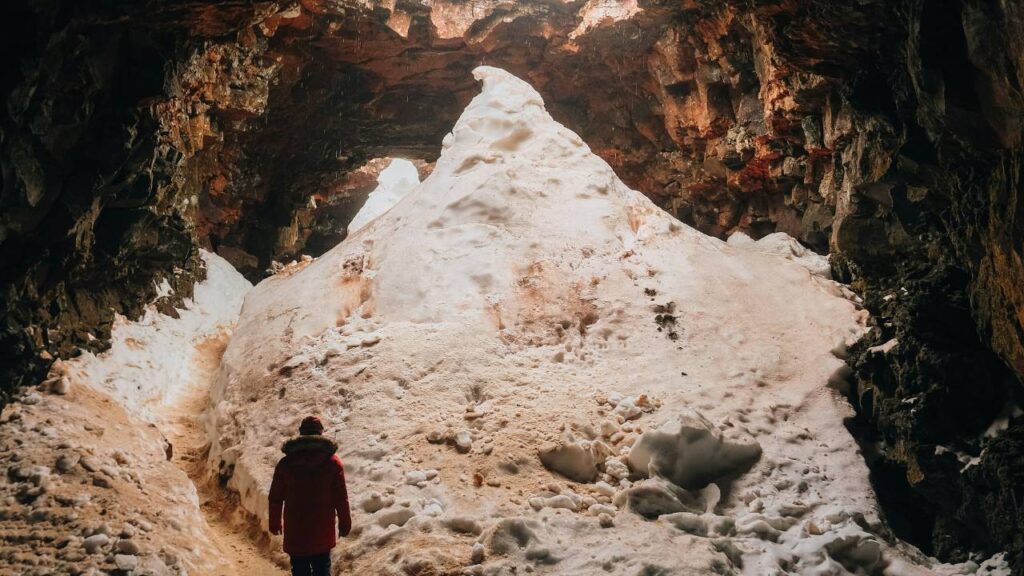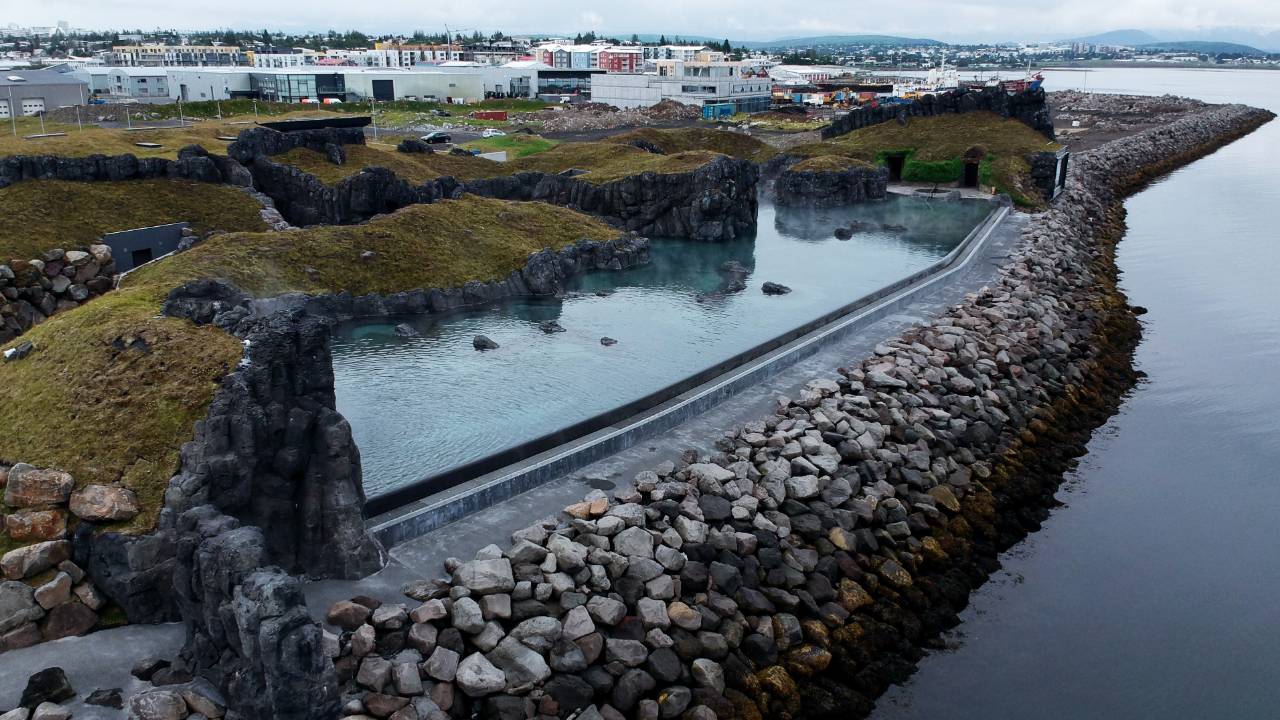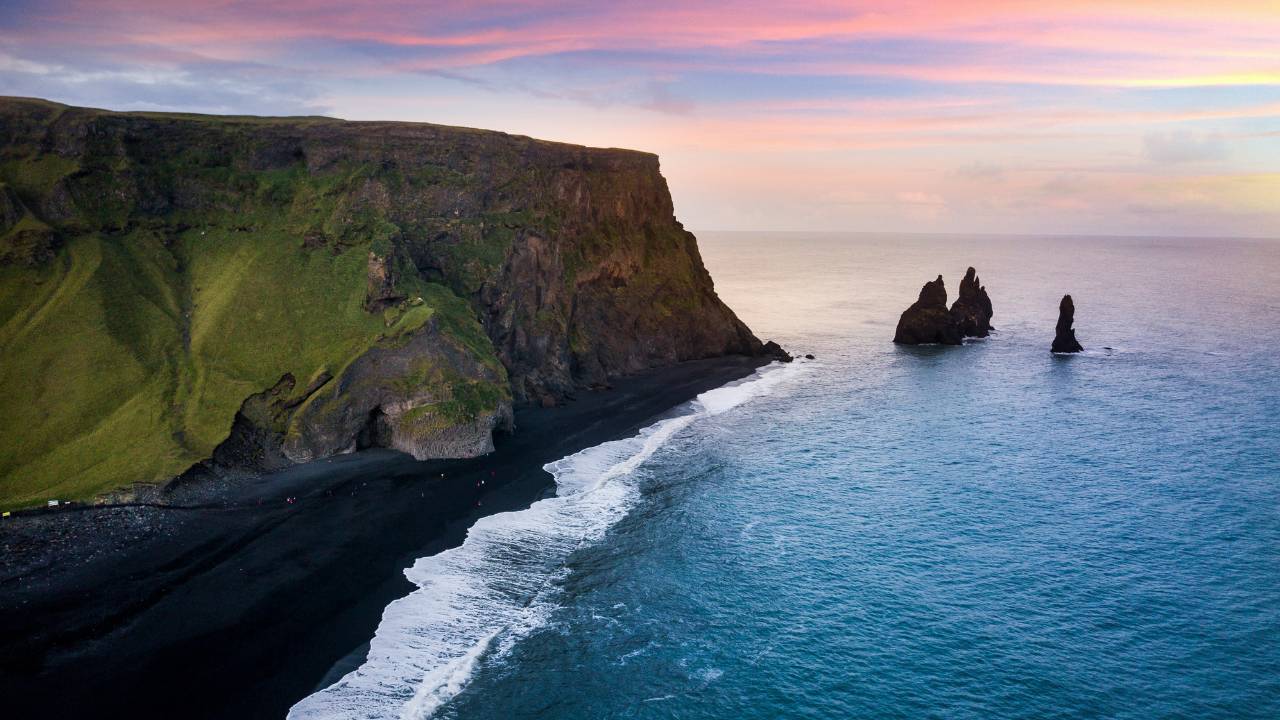Raufarhólshellir, one of the longest lava tunnels in Iceland, invites you to explore an extraordinary subterranean world. Formed over 5,000 years ago during a volcanic eruption, this remarkable tunnel stretches over 1,360 metres, offering a glimpse into the raw power of Earth’s geological processes. As you step into the mouth of Raufarhólshellir, you’re walking through the same paths that once channelled molten lava from the Leitahraun eruption, an experience that connects you directly to Iceland’s volcanic heritage.
The tunnel’s interior is a showcase of natural wonders, featuring a variety of rock formations and a spectrum of colours. Stalactites and stalagmites of cooled lava create a rugged, otherworldly landscape, while the walls shimmer with shades of red, yellow, and black due to the different minerals solidified in the rock. Your journey through Raufarhólshellir isn’t just a simple walk; it’s a sensory engagement with the beauty and complexity of geological transformations that have occurred over millennia.
As you navigate the tunnel, you’ll notice the changes in the cave’s atmosphere and acoustics. The silence of the underground is profound, punctuated only by the sound of water droplets hitting the ground, a reminder of the dynamic forces that continue to shape the tunnel. Raufarhólshellir’s accessibility makes it an ideal adventure for beginners keen to dip their toes into the world of caving, yet its complexity and grandeur are sure to captivate even the most experienced adventurers.
Exploring Raufarhólshellir
Raufarhólshellir, one of the longest lava tunnels in Iceland, offers a unique opportunity to witness geological marvels. As you walk through this subterranean wonder, you will be surrounded by fascinating geological formations and traces of volcanic history.
Touring the Lava Tunnel
When you set foot in Raufarhólshellir lava tunnel, you are greeted by a wealth of colours and textures. Guided tours are available, which vary in length and difficulty:
- Standard Tour: Ideal for most visitors, lasting approximately 1 hour.
- Adventure Tour: A more challenging, 3-4 hour expedition for the more adventurous.
Both tours provide helmets, lights, and expert guidance to ensure your safety as you navigate the tunnel’s interior. You’ll encounter stunning features, such as:
- Icicle-like stalactites reaching down from the ceiling
- Solidified lava falls, frozen in time
- Smooth walls streaked with oxidised iron, creating a palette of red, yellow, and orange hues
Remember to wear sturdy footwear and dress warmly to suit the tunnel’s cooler temperatures.
Geological Significance
Once inside Raufarhólshellir, you become an eyewitness to the island’s dynamic volcanic activity. As a classic example of a lava tube, the tunnel was formed by flowing lava moving beneath the hardened surface of a lava flow. Details to note include:
- Tunnels within the tube: See how flowing lava created multiple paths.
- Varieties of rock formations: Study the tunnel’s basaltic rock, which reveals much about the lava’s composition.
Scientists have sampled minerals in the tunnel, such as iron, to better understand the conditions of the eruption that formed this natural structure. The presence of different minerals, including iron, is indicated by colours and formations in the tunnel, providing a visual journey through its geological history.
Throughout your visit, you will appreciate how geological features in Raufarhólshellir are records of the Earth’s volcanic processes.
Location and Accessibility
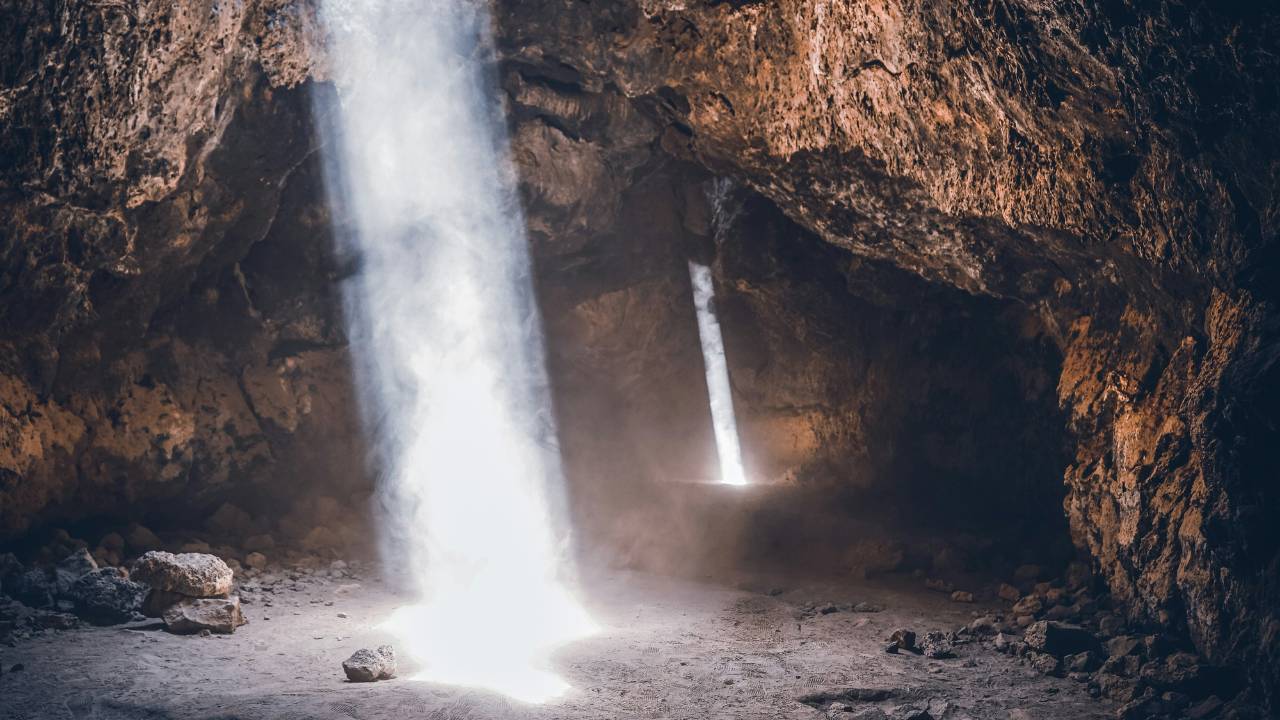
Visiting Raufarhólshellir offers a unique opportunity to explore one of Iceland’s most accessible lava tunnels, located within a comfortable distance from Reykjavík.
Getting to Raufarhólshellir
To make your way to Raufarhólshellir, you’ll head out on a scenic drive from the capital city, Reykjavík. You’ll take Route 1, also known as Ring Road, and travel eastwards. After a short drive, you will transition onto Route 39, which will lead you directly to the lava tunnel. The journey from Reykjavík to Raufarhólshellir is fairly straightforward and takes about 30 minutes.
The exact GPS coordinates for Raufarhólshellir are 63.9432° N, 21.3964° W. Entering these coordinates into your GPS device will guide you seamlessly to the parking area.
Navigating Inside the Cave
Upon arrival at Raufarhólshellir, you’ll find an organised infrastructure designed for visitors’ convenience. Well-defined paths have been created to ensure a safe and enjoyable exploration of the tunnel. You are recommended to stay on the paths to protect both the delicate cave environment and for your safety.
As you move through the cave, you’ll encounter a series of platforms and stairs that facilitate access to different sections of the tunnel. These structures enable you to delve deeper into the tunnel without the need for specialised climbing equipment. The cave’s natural beauty is accentuated by subtle lighting installed at various points along the path, enhancing features without overwhelming the natural ambiance.
Please note that the temperature inside the cave stays around 0°C to 4°C throughout the year, so it’s advised you wear warm clothing and good shoes with a grip to manage the uneven ground.
Formation and History
Your journey through the Raufarhólshellir lava tunnel starts with understanding its incredible formation and the moments of discovery that have made it accessible to you today.
Leitahraun Eruption
The inception of Raufarhólshellir is rooted in the Leitahraun eruption, an event that occurred approximately 5,200 years ago. As molten lava streamed across the landscape, it began to cool and solidify on the surface, forming a hard crust, while the fiery liquid beneath continued flowing. This process eventually created a hollow tube-like structure.
- Year of Eruption: ~3200 BC
- Type of Lava: Basaltic
- Mechanism: Pahoehoe lava flow, cooling and crust formation
Cave Discovery
The discovery of Raufarhólshellir is not attributed to a specific event in history or tied to legends such as those involving Noah or any Indian tribe. Rather, it’s presumed to have been known to the local inhabitants for centuries. Modern recognition and interest in the tunnel escalated when explorers and geologists started thoroughly mapping and studying its features in the 20th century.
- First Documented Study: 20th century
- Significant for: Geological importance and natural beauty
Visitor Experience
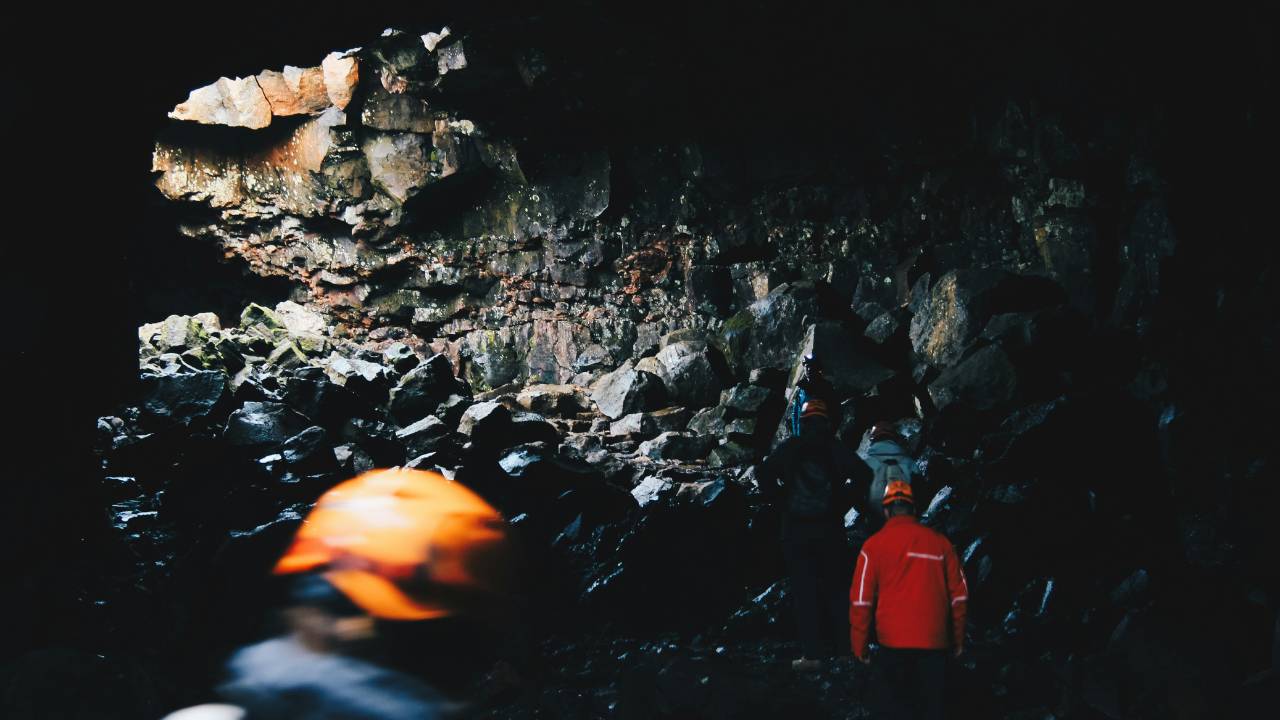
When you step into the Raufarhólshellir lava tunnel, you’re entering a world of geological wonder. Your journey will be enriched by expertly guided tours and the stunning natural artistry of the cave.
Guided Tours Offered
- Standard Tour: A 1-hour excursion suitable for most visitors.
- Availability: Tours run hourly with a cap of 19 participants.
- Booking: Pre-book online or purchase tickets on arrival (subject to availability).
- Adventure Tour: A more extensive 3-4 hour experience for the adventurous.
- Requirements: Good health and sturdy footwear.
- Features: Exclusive sections of the tunnel and smaller groups.
- Private Tour: Tailor a personal experience with an expert guide.
- Customisable: Choose your focus – photography, geology, or history.
- Enquiry: Contact directly for pricing and availability.
Each tour is equipped with helmets and lights. Nevertheless, dressing warmly is advised, as the temperature inside the tunnel is consistently lower than outside, regardless of season.
Cave’s Natural Artistry
As you traverse the tunnel, stalactites and stalagmites reveal themselves beneath the artful illumination, which is designed to enhance the subterranean atmosphere without compromising the cave’s integrity. In winter, you may be greeted with the mesmerising sight of ice sculptures.
- Formations: A diverse range of colours and shapes due to volcanic activity.
- Lighting: Thoughtfully placed to showcase the cave’s features without disturbing the environment.
Please remember to move carefully to both protect the delicate cave formations and for your own safety. Photography is encouraged, but tripods are best left above ground to avoid obstruction and potential harm to the cave’s features.
After exploring the captivating depths of Raufarhólshellir, you might find relaxation at the Sky Lagoon or the iconic Blue Lagoon an ideal complement to your adventurous Iceland holiday. These geothermal spas offer a perfect retreat, blending naturally with the island’s stunning landscapes.
Preservation Efforts
The preservation of Raufarhólshellir is crucial to maintaining its natural beauty and geological significance. Concerted efforts are being made to protect this remarkable cave environment.
Protecting the Cave Environment
Your visits to Raufarhólshellir come with a responsibility to respect the fragile cave environment. Preservation initiatives are put in place to prevent damage and ensure the longevity of the tunnel for future generations to experience.
- Pathways: To minimise your impact on the cave floor, raised boardwalks and designated paths are installed. Please stay on these paths to avoid disturbing the natural formations.
- Lighting: Low-impact LED lighting systems are utilised to illuminate the cave, designed to prevent alterations to the cave’s atmosphere while providing you with a safe and enjoyable viewing experience.
- Guided Tours: You’re encouraged to explore Raufarhólshellir with a guide. Their expertise ensures you learn about the cave without accidentally harming it.
- Safety Gear: Wearing a helmet is mandatory. Not only does it protect your head, but it also helps prevent damage to the cave should you accidentally bump against the rock formations.
- Information Boards: Educational boards along the tunnel inform you about the delicate environment and the importance of preservation. These are strategically placed to engage visitors and foster a culture of conservation.
- Monitoring and Maintenance: Regular inspections are key to maintaining the tunnel’s integrity. Any areas showing signs of wear or requiring repairs are promptly attended to by conservation specialists.
Your enjoyment of Raufarhólshellir comes with the duty to preserve it. Every measure is taken to ensure that the cave retains its majesty for years to come.
Nearby Attractions
As you marvel at the natural wonder that is Raufarhólshellir, take the opportunity to explore the surroundings teeming with attractions that are just a stone’s throw away.
Extended Exploration
- Bláfjöll Skiing Area: Just a 30-minute drive from Raufarhólshellir, the Bláfjöll Skiing Area offers both winter sports and hiking trails during the summer.
- Hveragerði Town: Known for its geothermal activity, visit Hveragerði and experience the hot springs, just 25 kilometres away.
- Reykjadalur Hot Springs: An adventurous hike that leads you to a steamy river of hot springs located near Hveragerði.
- South Coast: Embark on a day trip to explore Iceland’s majestic south coast, with its waterfalls, black sand beaches, and towering cliffs.
Preparing for Your Visit
Exploring Raufarhólshellir is a unique adventure that requires careful preparation. Equipping yourself properly and being aware of safety considerations will ensure a memorable experience as you traverse this majestic lava tunnel.
What to Bring
When you set out for Raufarhólshellir, there are essential items you should bring along to make the most of your journey:
- Sturdy Shoes: Wear comfortable, closed-toe shoes that provide good ankle support and grip.
- Clothing: Dress in warm layers, as temperatures inside the lava tunnel can be low. Include water-resistant outerwear.
| Must-Have Items | Description |
| Headlamp/Torch | Necessary for navigation as the tunnel is naturally dark. |
| Gloves | To protect your hands from sharp lava rock surfaces. |
| Snacks/Water | Stay energised and hydrated throughout your exploration. |
Safety Considerations
Safety is paramount when exploring the tunnel’s rugged paths and unique geological formations.
- Follow the Paths: Stick to designated paths to avoid damaging the delicate formations or getting lost.
- Heed the Rules: Always observe posted signs and guidance provided by your guide or local authorities.
- Be aware of your surroundings and move carefully to avoid slips or falls on the uneven terrain.
- In case of an emergency, know your exit points and have a means to call for help.
When planning your holiday in Iceland, consider our exclusive packages like the 3 Night Iceland Bronze Package, 3 Night Iceland Silver Package, 3 Night Iceland Gold Package, and 3 Night Iceland Standard Break. These packages provide a perfect blend of adventure and relaxation, ensuring a memorable exploration of Iceland’s natural wonders.
Understanding the Ecosystem
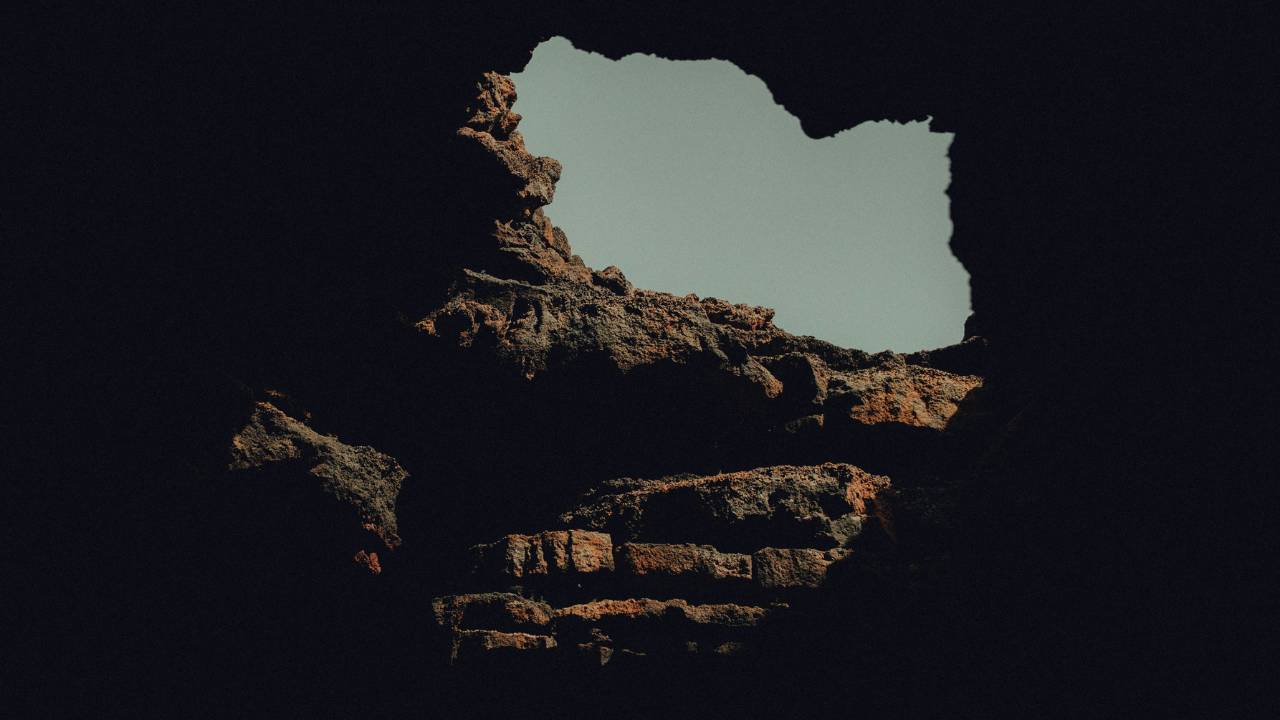
In Raufarhólshellir, you’ll find a delicate balance within its ecosystem, shaped by unusual lava formations and scarce light. Let’s explore this unique underground habitat.
Flora and Fauna
The lava tunnel’s ecosystem thrives under challenging conditions. Organisms here are often adapted to low-light environments. You might not see a sprawling variety of plants, but specially adapted mosses and fungi make the rough surfaces of the lava tunnel their home. These primary producers support a food web inclusive of insects and small invertebrates, which in turn may feed the occasional bat or bird that ventures into the tunnel.
- Biodiversity: Limited but fascinating, species have adapted to the dark and nutrient-poor conditions.
- Adaptations: Flora and fauna here have unique characteristics to survive with minimal sunlight.
Cave Dynamics
The interior of Raufarhólshellir is dynamic and harbouring features such as lava straws and lava falls, which play a pivotal role in the structural and ecological makeup of the cave.
- Lava Straws: Thin tubular stalactites formed from dripping lava, adding to the cave’s complexity.
- Lava Falls: Resemble waterfalls but are solidified lava, creating unique microhabitats.
- Skylights: Openings where the cave ceiling has collapsed, allowing light to penetrate, form natural oases of life.
The cave’s dynamic environment includes the occasional infusion of light via skylights, which creates patches where life is more pronounced due to the presence of photosynthetic organisms. These oases of life within the cave contribute significantly to the cave’s overall ecosystem and help maintain its biodiversity.
